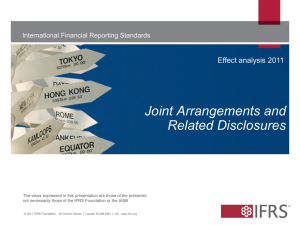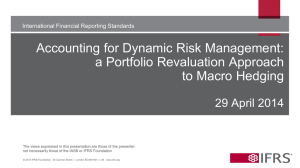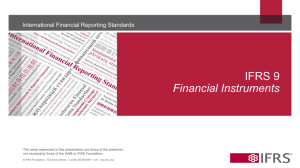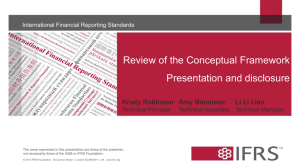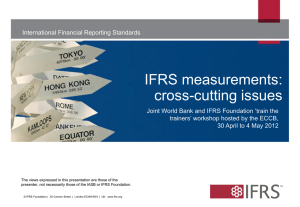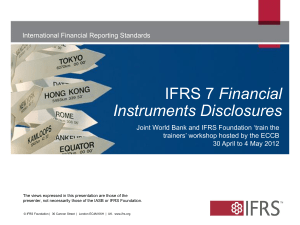Framework
advertisement
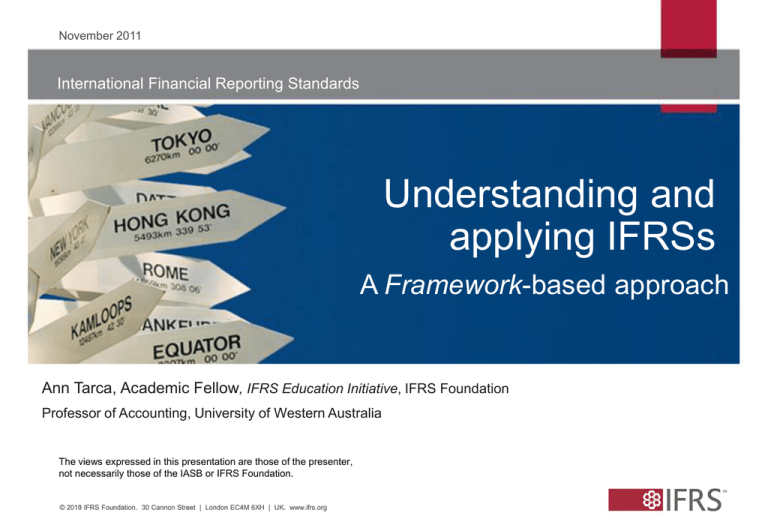
November 2011 International Financial Reporting Standards Understanding and applying IFRSs A Framework-based approach Ann Tarca, Academic Fellow, IFRS Education Initiative, IFRS Foundation Professor of Accounting, University of Western Australia The views expressed in this presentation are those of the presenter, not necessarily those of the IASB or IFRS Foundation. © 2011 2010 IFRS Foundation. 30 Cannon Street | London EC4M 6XH | UK. www.ifrs.org Framework-based understanding… 2 • relates IFRS requirements to the concepts in the Conceptual Framework • reasons why some IFRS requirements do not maximise those concepts (eg application of the cost constraint or inherited requirements) Concepts Principles © 2010 IFRS Foundation. 30 Cannon Street | London EC4M 6XH | UK. www.ifrs.org Rules Does the Framework help me understand IFRSs? 3 • Yes, the starting point for understanding all IFRS information is the objective and the concepts that flow logically from that objective: – IASB uses Framework to set IFRSs – Teachers/Trainers use Framework-based teaching to prepare students to make judgements that are necessary to apply IFRSs – Preparers use Framework to make the judgements that are necessary to apply IFRSs – Auditors and regulators assess those judgements – Investors, lenders and others consider those judgements when using IFRS financial information to inform their decisions © 2011 IFRS Foundation. 30 Cannon Street | London EC4M 6XH | UK. www.ifrs.org The IASB’s Conceptual Framework • Framework sets out agreed concepts that underlie IFRS financial reporting – the objective of general purpose financial reporting – qualitative characteristics – elements of financial statements – recognition – measurement – presentation and disclosure Other concepts all flow from the objective © 2011 IFRS Foundation. 30 Cannon Street | London EC4M 6XH | UK. www.ifrs.org 4 Objective of financial reporting 5 “Provide financial information about the reporting entity that is useful to existing and potential investors, lenders and other creditors in making decisions about providing resources to the entity.” Those decisions involve buying, selling or holding equity and debt instruments, and providing or settling loans or other forms of credit © 2011 IFRS Foundation. 30 Cannon Street | London EC4M 6XH | UK. www.ifrs.org Objective of financial reporting • Primary users – provide resources, but cannot demand information – common information needs • Assess the prospects for future net cash inflows – buy, sell, hold – efficient and effective use of resources © 2011 IFRS Foundation. 30 Cannon Street | London EC4M 6XH | UK. www.ifrs.org 6 Fundamental qualitative characteristics • Relevance – predictive value – confirmatory value – materiality, entity-specific • Faithful representation (replaces reliability) – completeness – neutrality – free from error © 2011 IFRS Foundation. 30 Cannon Street | London EC4M 6XH | UK. www.ifrs.org 7 Enhancing qualitative characteristics • Comparability • Verifiability • Timeliness • Understandability © 2011 IFRS Foundation. 30 Cannon Street | London EC4M 6XH | UK. www.ifrs.org 8 Pervasive constraint 9 • Cost – IASB assesses whether the benefits of reporting particular information are likely to justify the costs incurred to provide and use that information. Note: It is consistent with the Framework for an IFRS requirement not to maximise the qualitative characteristics of financial information and other main Framework concepts when the costs of doing so would exceed the benefits. © 2011 IFRS Foundation. 30 Cannon Street | London EC4M 6XH | UK. www.ifrs.org Concepts and principles: Definitions Asset 10 Equity = assets less liabilities Income • recognised increase in asset/decrease in liability in • result of past event current reporting period • expected inflow of economic • that result in increased benefits equity except… Liability Expense • present obligation • recognised decrease in • arising from past event asset/increase in liability in current reporting period • expected outflow of economic benefits • that result in decreased equity except… • resource controlled by the entity © 2011 IFRS Foundation. 30 Cannon Street | London EC4M 6XH | UK. www.ifrs.org Application (1) 11 • Framework: A common definition of assets (irrespective of tangible or intangible nature) • Standards: An intangible asset is an identifiable nonmonetary asset without physical substance (IAS 38.7) • Examples that meet the definition/s – A legally protected brand name, purchased from a competitor; An exclusive right to operate in a particular jurisdiction • Examples that do not meet the definition/s – Loyal and skilled employees; Popular bread, based on a public recipe © 2010 IFRS Foundation. 30 Cannon Street | London EC4M 6XH | UK. www.ifrs.org Concepts and principles: Recognition 12 • The concept: recognise element (eg asset) when – probable that benefits will flow to/from the entity – has cost or value that can measured reliably (see ¶4.38) • The principle – recognise elements (eg asset) when they satisfy the definition and recognition criteria (see ¶ IAS1.28) • Applying the principle (see individual IFRSs) What does probable mean? © 2010 IFRS Foundation. 30 Cannon Street | London EC4M 6XH | UK. www.ifrs.org Recognition criteria 13 IAS 16 7 The cost of an item of property, plant and equipment shall be recognised as an asset if, and only if: (a) it is probable that future economic benefits associated with the item will flow to the entity; and (b) the cost of the item can be measured reliably. IAS 38 21 An intangible asset shall be recognised if, and only if: (a) it is probable that the expected future economic benefits that are attributable to the asset will flow to the entity; and (b) the cost of the asset can be measured reliably. 22 An entity shall assess the probability of expected future economic benefits using reasonable and supportable assumptions that represent management’s best estimate of the set of economic conditions that will exist over the useful life of the asset. © 2010 IFRS Foundation. 30 Cannon Street | London EC4M 6XH | UK. www.ifrs.org Application (2) 14 • Framework: Common recognition criteria (irrespective of tangible or intangible nature) • Standards: Identifiable intangible assets (identifiable, non-monetary, lack physical substance) • Examples: mastheads, trade names, licences, websites, software • Additional requirements in a business combination – Identifiable means separable, arising from a legal right • Examples: Trademark, artistic work protected by patent, customer contracts. © 2010 IFRS Foundation. 30 Cannon Street | London EC4M 6XH | UK. www.ifrs.org Rules (1) 15 • Certain costs do not form part of an asset – Cost of advertising and promotion (IAS 16, para 19; IAS 38 para 20(a)) • Internally generated goodwill shall not be recognised as an asset (IAS 38, para 48) • Expenditure on research shall be expensed when incurred (IAS 38, para 54) • Relate back to the concepts and principles – do these items meet definition and recognition criteria? © 2010 IFRS Foundation. 30 Cannon Street | London EC4M 6XH | UK. www.ifrs.org Rules (2) 16 IAS 38.57 An intangible asset arising from development (or from the development phase of an internal project) shall be recognised if, and only if, an entity can demonstrate all of the following: (a) the technical feasibility of completing the intangible asset so that it will be available for use or sale. (b) its intention to complete the intangible asset and use or sell it. (c) its ability to use or sell the intangible asset. (d) how the intangible asset will generate probable future economic benefits. Among other things, the entity can demonstrate the existence of a market for the output of the intangible asset or the intangible asset itself or, if it is to be used internally, the usefulness of the intangible asset. (e) the availability of adequate technical, financial and other resources to complete the development and to use or sell the intangible asset. (f) its ability to measure reliably the expenditure attributable to the intangible asset during its development. © 2010 IFRS Foundation. 30 Cannon Street | London EC4M 6XH | UK. www.ifrs.org Class activity: Definition and recognition criteria • Class examples and discussion • Page x, Page x © 2010 IFRS Foundation. 30 Cannon Street | London EC4M 6XH | UK. www.ifrs.org 17 Measurement concepts 18 • Measurement is the process of determining monetary amounts at which elements are recognised and carried. (¶4.54) • To a large extent, financial reports are based on estimates, judgements and models rather than exact depictions. The Framework establishes the concepts that underlie those estimates, judgements and models (¶OB11) • IASB guided by objective and qualitative characteristics when specifying measurements. © 2010 IFRS Foundation. 30 Cannon Street | London EC4M 6XH | UK. www.ifrs.org Measurement section of Framework 19 • Measurement section of Framework is weak―only lists some measurement methods used in practice: – historical cost: cash paid or fair value of consideration given – current cost: cash that would be paid if acquired now – realisable (settlement) value: cash that could be obtained by selling the asset now – present value: present discounted value of future net cash inflows that the item is expected to generate – market value: listed but not described in Framework. For fair value see IFRS 13 Fair Value Measurements © 2010 IFRS Foundation. 30 Cannon Street | London EC4M 6XH | UK. www.ifrs.org Concepts and principles: Measurement 20 • A common approach to measurement for tangible and intangible assets: – Initial measurement at cost, examples of elements to be included in cost • IAS 16.15 An item of property plant and equipment that qualifies for recognition as an asset shall be measured at its cost. • IAS 38.24 An intangible asset shall be measured initially at cost. • Use of fair value – IFRS 3, IAS 38.35-41 • Revaluation model – Active market (IAS 38.75) © 2010 IFRS Foundation. 30 Cannon Street | London EC4M 6XH | UK. www.ifrs.org Measurement – intangible assets (1) • Use of fair value • Principle: The acquirer shall measure the identifiable assets acquired …at their acquisition date fair value (IFRS 3.18) • To meet objective: relevance, comparable, understandable (IFRS 3 BC198). © 2010 IFRS Foundation. 30 Cannon Street | London EC4M 6XH | UK. www.ifrs.org 21 Measurement – intangible assets (2) • Principle: Fair value is the amount for which an asset could be exchanged between knowledgeable, willing parties in an arm’s length transaction (IFRS 3.7) • Quoted market prices; recent transactions; measurement models • Fair value hierarchy (IFRS 13) • Market based measures preferred by may not be available for some intangible assets • Estimation and judgement © 2010 IFRS Foundation. 30 Cannon Street | London EC4M 6XH | UK. www.ifrs.org 22 Measurement – intangible assets (3) 23 • An entity shall use valuation techniques that are appropriate to the circumstances and for which sufficient data are available to measure fair value, maximising the use of relevant observable inputs and minimising the use of unobservable inputs (IFRS 13.61) – Market approach (prices and other information for identical or comparable assets) – Cost approach (current replacement cost) – Income approach (present value ie discounted future cash flows; option pricing models eg Black Scholes Merton or binomial; excess earnings) (IFRS 13 B5-B34) © 2010 IFRS Foundation. 30 Cannon Street | London EC4M 6XH | UK. www.ifrs.org Depreciation and amortisation: concepts 24 • Information about an entity’s financial performance in a period, reflected by changes in economic resources is useful in assessing the entity’s past and future ability to generate net cash inflows (see ¶OB18) • Expenses are decreases in economic benefits during an accounting period in the form of depletions of assets… (¶4.25) • Depreciation/amortisation represents the consumption of the asset’s service potential in the period. © 2010 IFRS Foundation. 30 Cannon Street | London EC4M 6XH | UK. www.ifrs.org Allocating depreciation: principle 25 • Depreciation is the systematic allocation of the depreciable amount of an asset over its useful life (IAS16.6) • Finite vs indefinite life (IAS 38.88-90). • Land is not depreciated – indefinite useful life • The depreciable amount of an intangible asset with a finite useful life shall be allocated on a systematic basis over its useful life (IAS 38.97) © 2010 IFRS Foundation. 30 Cannon Street | London EC4M 6XH | UK. www.ifrs.org Depreciation/amortisation: application guidance (1) 26 • Systematic allocation (application guidance): – Depreciation/amortisation method must closely reflects the pattern in which the asset’s future economic benefits are expected to be consumed by the entity. – If a pattern cannot be reliably determined, straight line amortisation shall be used (IAS38.97) – Residual value is assumed to be zero, unless specific circumstances exist (IAS38.100) © 2010 IFRS Foundation. 30 Cannon Street | London EC4M 6XH | UK. www.ifrs.org Application guidance (2) 27 • Depreciable amount = – cost model: historical cost less residual value – revaluation model: fair value less residual value • Residual value = – amount that the entity would currently obtained from disposal of asset (less estimated disposal costs) if the asset were already of the age and in the condition expected at the end of its useful life © 2010 IFRS Foundation. 30 Cannon Street | London EC4M 6XH | UK. www.ifrs.org Application guidance (3) 28 • Useful life (entity specific) = – the period over which the asset is expected to be available for use by the entity; or – the number of production or similar units expected to be obtained from the asset by the entity. • Consequently, depreciation continues when idle (if useful life = period) • However, depreciation ceases when classified as held for sale because IFRS 5 measurement is essentially a process of valuation, rather than allocation (IFRS5.BC29) © 2010 IFRS Foundation. 30 Cannon Street | London EC4M 6XH | UK. www.ifrs.org Case study • Class examples and discussion • Page xx © 2010 IFRS Foundation. 30 Cannon Street | London EC4M 6XH | UK. www.ifrs.org 29 Derecognition of assets 30 • Derecognition of an asset refers to when an asset previously recognised by an entity is removed from the entity’s statement of financial position – derecognition requirements are specified at the standards level. (eg IAS 38.112) – derecognition does not necessarily occur when the asset no longer satisfies the conditions specified for its initial recognition (ie derecognition does not necessarily coincide with the loss of control of the asset ) • IASB guided by objective, qualitative characteristics and elements © 2010 IFRS Foundation. 30 Cannon Street | London EC4M 6XH | UK. www.ifrs.org Presentation and disclosure 31 • Presentation: financial statements portray financial effects of transactions and events by: – grouping into broad classes (the elements, eg asset) – sub-classify elements (eg assets sub-classified by their nature or function in the business) • IAS 1 – application of IFRSs with additional disclosures when necessary results in a fair presentation (faithful representation of transactions, events and conditions) – do not offset assets & liabilities or income & expenses • IASB guided by objective and qualitative characteristics © 2010 IFRS Foundation. 30 Cannon Street | London EC4M 6XH | UK. www.ifrs.org Framework-based understanding provides… 32 • a cohesive understanding of IFRSs – Framework facilitates consistent and logical formulation of IFRSs • a basis for judgement in applying IFRSs – Framework established the concepts that underlie the estimates, judgements and models on which IFRS financial statements are based • a basis for continuously updating IFRS knowledge and IFRS competencies © 2010 IFRS Foundation. 30 Cannon Street | London EC4M 6XH | UK. www.ifrs.org Framework’s role in applying IFRSs 33 Does the Framework help me apply IFRSs? • Yes, Framework is in IAS 8 hierarchy (see next slide) – Preparers use the Framework to make the judgements that are necessary to apply IFRSs – Auditors and regulators assess those judgements – Investors, lenders and others consider those judgements when using IFRS financial information to inform their decisions © 2011 IFRS Foundation. 30 Cannon Street | London EC4M 6XH | UK. www.ifrs.org If no specific IFRS requirement 34 • Use judgement to – develop a policy that results in relevant information that faithfully represents (ie complete, neutral and error free) – Hierarchy: 1st IFRS dealing with similar and related issue 2nd Framework definitions, recognition crit. etc Can also in parallel refer to GAAPs with similar Framework © 2011 IFRS Foundation. 30 Cannon Street | London EC4M 6XH | UK. www.ifrs.org In other words, if no IFRS requirement… 35 Framework-based approach would ask: • What is the economics of the phenomenon (eg transaction or event)? • What relevant information using the accrual basis of accounting faithfully present that economic phenomenon to inform decisions of investors and lenders (potential and existing)? • Is there anything in IFRSs that prevents me from providing that information? © 2011 IFRS Foundation. 30 Cannon Street | London EC4M 6XH | UK. www.ifrs.org Common misunderstandings The Framework does not… include a matching concept include prudence/conservatism concept include an element other comprehensive income (or a concept for OCI) mention management intent or business model © 2010 IFRS Foundation. 30 Cannon Street | London EC4M 6XH | UK. www.ifrs.org 36 Clarification—the Framework includes accrual basis of accounting— recognise elements when satisfy definition and recognition criteria neutrality concept only the following elements— asset, liability, equity, income and expense Common misunderstandings continued Misunderstanding Principles are necessarily less rigorous than rules There are few judgements and estimates in cost-based measurements © 2010 IFRS Foundation. 30 Cannon Street | London EC4M 6XH | UK. www.ifrs.org 37 Clarification Rules are the tools of financial engineers Inventory, eg allocate joint costs and production overheads PP&E, eg costs to dismantle/restore site, useful life, residual value, depreciation method Provisions, eg uncertain timing and amount of expected future cash flows Support for Framework-based teaching 38 • IFRS Foundation education initiative works with others to support Framework-based teaching – create awareness – develop material (starting with PPE) – hold workshops (in 2011: Basseterre and Vienna with World Bank; Bucharest, Denver, George and Venice with IAAER; and Rio with BNDES) – encourage those certifying accountants to examine their students’ ability to make the judgements that are necessary to apply IFRSs © 2010 IFRS Foundation. 30 Cannon Street | London EC4M 6XH | UK. www.ifrs.org Questions or comments? Expressions of individual views by members of the IASB and their staff are encouraged. The views expressed in this presentation are those of the presenter. Official positions of the IASB on accounting matters are determined only after extensive due process and deliberation. © 2011 IFRS Foundation. 30 Cannon Street | London EC4M 6XH | UK. www.ifrs.org 39
